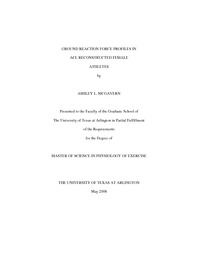| dc.description.abstract | Injury to the anterior cruciate ligament (ACL) has become a global topic of
research, as the number of injuries is staggering and continues to increase each year
because the underlying elements contributing to this injury have yet to be fully grasped.
It is estimated that 80,000 – 250,000 ACL injuries occur annually in female
athletics.(45) As a result, an estimated number of 100,000 ACL reconstructions are
performed annually.(2) The uncertainty involving the contributing causes of this injury
has naturally ushered uncertainty involving the treatment of the injury, i.e. surgical
repair and subsequent rehabilitation. Although considerable gains toward improving
surgical procedure and rehabilitation have been achieved over the last decade, there exists much debate as to the proper criteria-based rehabilitation for return
to pre-injury activity level.
Current “accelerated” rehabilitation now consists of immediate weightbearing,
aggressive restoration of ROM, strength and functional progression based upon certain
criteria, and a quick return to play for athletes. (88;96;101;123;125) However,
ipsilateral and contralateral ACL injuries, as well as early onset of osteoarthritis have
become a significant occurrence: studies have shown that there is a 10-12% risk of
reinjury to the ipsilateral or contralateral limb and a 59%-100% chance of developing
osteoarthritis 7-15 years after an ACL disruption. (15;46;65;67;90;91;104;107;108;
112;113)
One of the contributing causes to the reinjury rate and osteoarthritis is the
absence of applicable guidelines for criteria-based progression through an ACL
rehabilitation program suitable to various age groups and activity levels. According to
current rehabilitation protocol, return to full participation is most commonly granted at
4-7 months after a subjective evaluation based on knee range of motion (ROM)
measurements, eccentric/concentric strength ratios, graft stability, subjective medical
opinion(s), and the athlete’s perceived ability to play at his/her previous
level.(13;82;92) Because dynamic, high-impact movements are a major component to
athletics, static measurements, eccentric/concentric comparisons, and functional jump
tests for time or distance may not adequately take into account an individual’s
interaction with the ground. We believe the examination of an individual’s dynamic interaction with the ground may provide a better method to assess ACL’s functional
stability under game condition.
The ground reaction force profiles of two healthy, young female athletes, at six
months post ACL reconstruction, were evaluated as they performed a series of jumplanding
tasks in order to determine if there was a significant (>10%) asymmetry in force
attenuation between limbs. The subjects were assessed for time to peak force, impact
force, peak force magnitude, peak knee flexion, and impulse in the vertical direction. | en_US |

